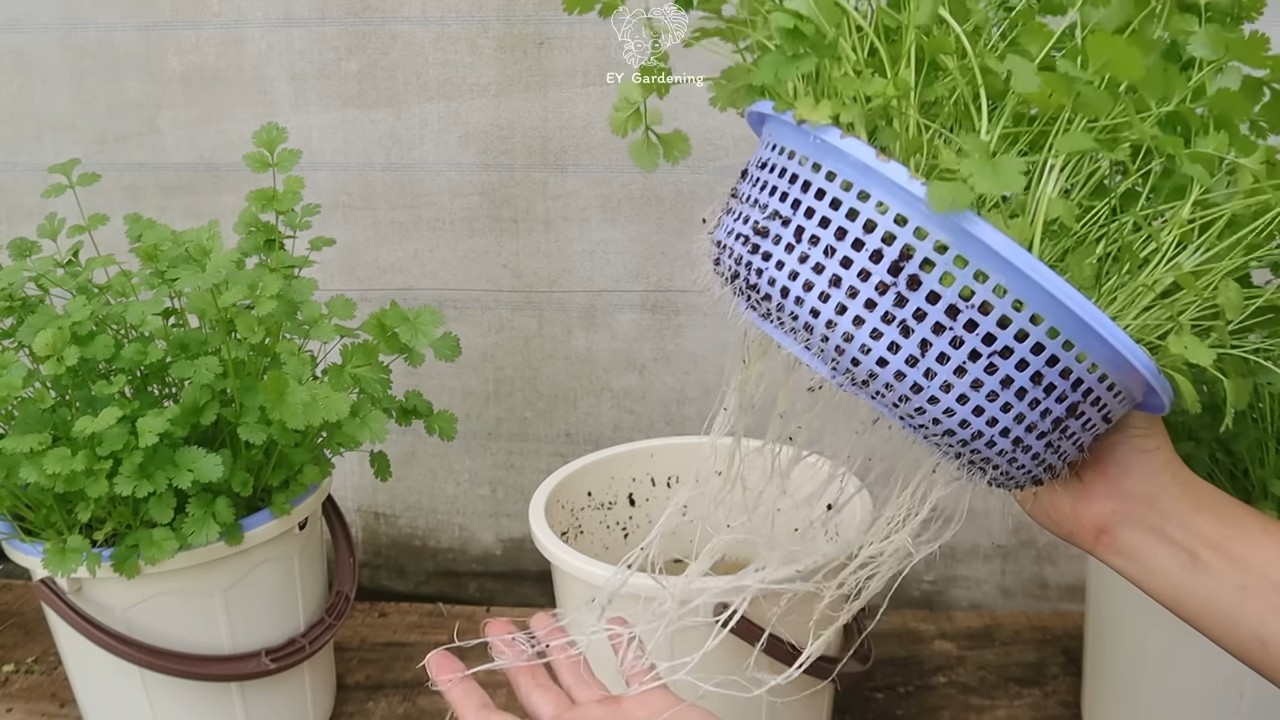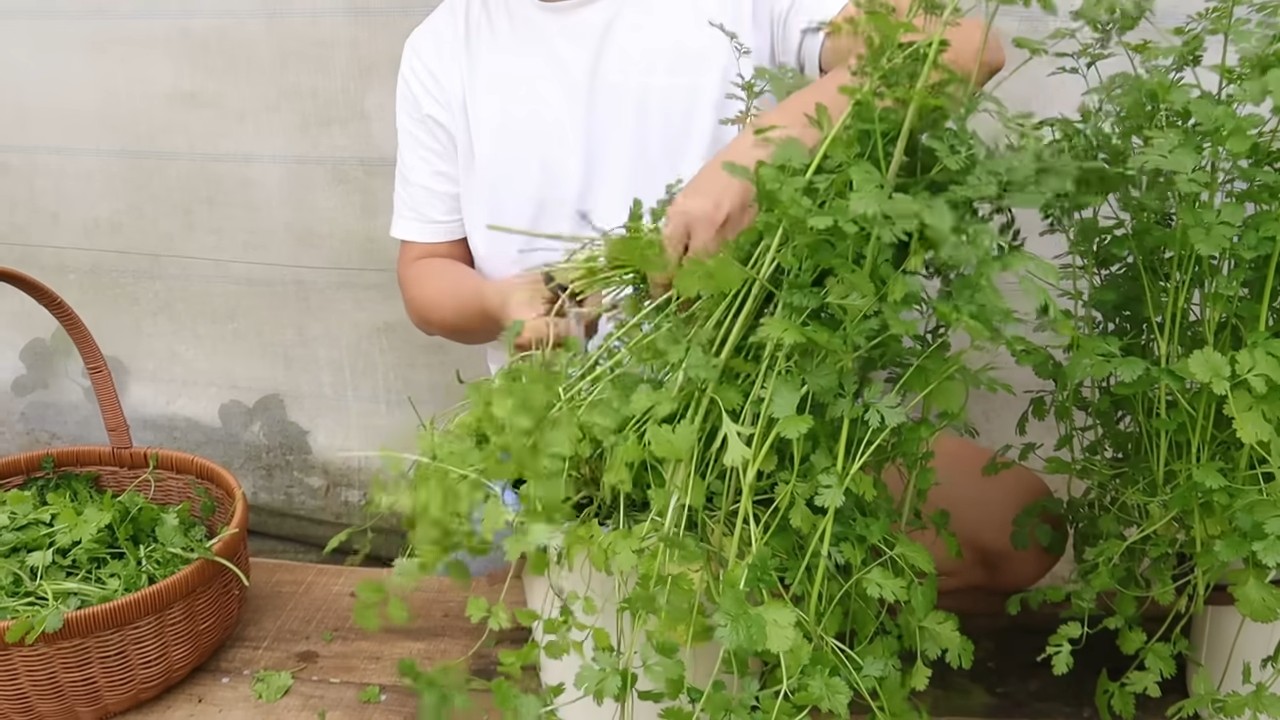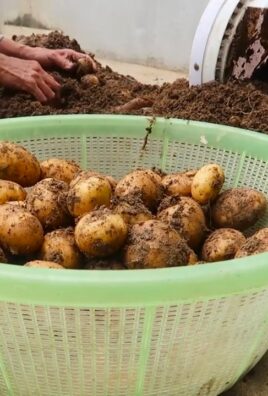Growing Coriander in Water: Imagine fresh, vibrant coriander always at your fingertips, ready to elevate your culinary creations! No more sad, wilted bunches from the grocery store. This DIY guide unlocks the secrets to effortlessly cultivating this fragrant herb right in your kitchen, using just water.
For centuries, coriander (also known as cilantro) has been a staple in cuisines around the globe, from the vibrant curries of India to the zesty salsas of Latin America. Its bright, citrusy flavor adds a unique dimension to countless dishes. But let’s face it, keeping coriander fresh can be a real challenge. That’s where this simple yet effective trick comes in!
Why should you learn this DIY hack? Because growing coriander in water is not only incredibly easy and cost-effective, but it also extends the life of your coriander significantly. Think of it as a mini-hydroponic system for your favorite herb! I’ll walk you through the process step-by-step, ensuring you have a thriving supply of fresh coriander whenever you need it. Say goodbye to food waste and hello to a constant burst of flavor in your meals!

Koriander in Wasser ziehen: So klappt’s!
Hey Leute, habt ihr auch manchmal das Problem, dass euer Koriander im Topf eingeht, bevor ihr ihn überhaupt aufbrauchen könnt? Ich kenne das nur zu gut! Aber keine Sorge, ich habe da einen super einfachen Trick für euch, wie ihr Koriander in Wasser ziehen und so länger frisch halten könnt. Und das Beste daran: Es ist super easy und ihr braucht kaum Material! Los geht’s!
Was du brauchst:
* Ein Bund frischen Koriander
* Ein sauberes Glas oder eine Vase
* Wasser (am besten gefiltert oder abgestanden)
* Eine Plastiktüte oder Frischhaltefolie (optional)
* Ein Gummiband (optional)
Schritt-für-Schritt-Anleitung:
1. Koriander vorbereiten: Zuerst nehme ich den Korianderbund und schaue ihn mir genau an. Ich entferne alle gelben oder welken Blätter. Die wollen wir ja nicht im Wasser haben, die würden nur faulen und das Wasser verunreinigen. Dann schneide ich die Stiele unten gerade ab. So können sie das Wasser besser aufnehmen. Ungefähr 1-2 cm reichen da.
2. Glas vorbereiten: Jetzt nehme ich mein sauberes Glas oder meine Vase. Es ist wichtig, dass das Gefäß sauber ist, damit sich keine Bakterien bilden, die den Koriander schaden könnten. Ich spüle es meistens noch mal kurz mit heißem Wasser aus.
3. Wasser einfüllen: Ich fülle das Glas mit frischem Wasser. Achtet darauf, dass das Wasser nicht zu kalt ist, Zimmertemperatur ist ideal. Ich verwende am liebsten gefiltertes Wasser oder lasse das Leitungswasser vorher etwas stehen, damit das Chlor verdunsten kann. Koriander ist da manchmal etwas empfindlich.
4. Koriander ins Wasser stellen: Jetzt kommt der Koriander ins Spiel! Ich stelle den Korianderbund so ins Wasser, dass die Stiele gut bedeckt sind, aber die Blätter nicht im Wasser hängen. Wenn die Blätter im Wasser sind, faulen sie schnell.
5. Blätter schützen (optional): Um die Blätter vor dem Austrocknen zu schützen, könnt ihr eine Plastiktüte oder Frischhaltefolie locker über den Koriander stülpen. Achtet aber darauf, dass die Tüte nicht ganz dicht ist, damit noch Luft zirkulieren kann. Ich befestige die Tüte dann meistens mit einem Gummiband am Glas. Das ist aber wirklich optional, ich mache das nicht immer.
6. Standort wählen: Jetzt suche ich dem Koriander einen guten Platz. Am besten ist ein heller Standort, aber nicht in direkter Sonneneinstrahlung. Ein Platz auf der Fensterbank ist ideal, aber achtet darauf, dass es dort nicht zu heiß wird.
7. Wasser regelmäßig wechseln: Das ist super wichtig! Ich wechsle das Wasser alle ein bis zwei Tage. So bleibt das Wasser sauber und der Koriander frisch. Beim Wasserwechsel spüle ich auch kurz das Glas aus, um eventuelle Ablagerungen zu entfernen.
8. Koriander ernten: Wenn ihr Koriander braucht, könnt ihr einfach die benötigten Blätter abzupfen oder mit einer Schere abschneiden. Achtet darauf, nicht zu viele Blätter auf einmal zu entfernen, damit der Koriander weiterwachsen kann.
Tipps und Tricks für noch längere Frische:
* Koriander richtig kaufen: Achtet beim Kauf darauf, dass der Koriander frisch aussieht und keine gelben oder welken Blätter hat. Die Stiele sollten fest und saftig sein.
* Koriander richtig lagern: Wenn ihr den Koriander nicht sofort ins Wasser stellen könnt, wickelt ihn in ein feuchtes Küchentuch und legt ihn ins Gemüsefach des Kühlschranks. So hält er sich ein paar Tage länger.
* Koriander einfrieren: Wenn ihr zu viel Koriander habt, könnt ihr ihn auch einfrieren. Dazu hackt ihr den Koriander klein und füllt ihn in Eiswürfelbehälter. Dann mit Wasser auffüllen und einfrieren. So habt ihr immer frischen Koriander zur Hand.
* Koriander trocknen: Ihr könnt Koriander auch trocknen. Dazu hängt ihr den Korianderbund kopfüber an einem trockenen, luftigen Ort auf. Wenn der Koriander trocken ist, könnt ihr ihn zerbröseln und in einem luftdichten Behälter aufbewahren.
* Koriander im Topf: Wenn ihr den Koriander lieber im Topf ziehen möchtet, achtet darauf, dass er genügend Licht und Wasser bekommt. Koriander mag es feucht, aber nicht nass. Staunässe solltet ihr vermeiden.
* Koriander düngen: Koriander braucht nicht viel Dünger. Einmal im Monat mit einem milden Flüssigdünger düngen reicht vollkommen aus.
* Koriander umtopfen: Wenn der Koriander zu groß für den Topf wird, könnt ihr ihn umtopfen. Wählt einen Topf, der etwas größer ist als der alte.
* Koriander vermehren: Koriander lässt sich auch aus Samen vermehren. Die Samen könnt ihr im Frühjahr direkt ins Freiland säen.
Häufige Probleme und Lösungen:
* Koriander wird gelb: Wenn der Koriander gelb wird, kann das verschiedene Ursachen haben. Entweder bekommt er zu wenig Licht, zu viel Wasser oder er ist einfach schon zu alt. Versucht, den Standort zu wechseln, das Gießen anzupassen oder den Koriander durch einen neuen Bund zu ersetzen.
* Koriander fault: Wenn der Koriander fault, liegt das meistens an zu viel Feuchtigkeit. Achtet darauf, dass die Blätter nicht im Wasser hängen und wechselt das Wasser regelmäßig.
* Koriander wächst nicht: Wenn der Koriander nicht wächst, kann das an zu wenig Licht oder Nährstoffen liegen. Versucht, den Standort zu wechseln oder den Koriander zu düngen.
Warum Koriander in Wasser ziehen eine gute Idee ist:
* Längere Haltbarkeit: Der Koriander bleibt deutlich länger frisch als im Kühlschrank oder im Topf.
* Einfache Methode: Es ist super einfach und ihr braucht kaum Material.
* Immer griffbereit: Ihr habt den Koriander immer griffbereit und könnt ihn direkt verwenden.
* Dekorativ: Der Koriander im Glas sieht auch noch dekorativ aus.
Ich hoffe, dieser Artikel hat euch geholfen und ihr könnt jetzt euren Koriander erfolgreich in Wasser ziehen! Viel Spaß beim Ausprobieren! Lasst mich wissen, wie es bei euch funktioniert hat!

Conclusion
So, there you have it! Growing coriander in water is not just a quirky experiment; it’s a genuinely effective and rewarding way to ensure a constant supply of fresh herbs right at your fingertips. Forget those sad, wilted bunches from the grocery store that seem to expire the moment you get them home. This method offers a sustainable, cost-effective, and incredibly convenient solution for any home cook or gardening enthusiast.
Why is this a must-try? Because it simplifies the process of having fresh coriander readily available. No more last-minute trips to the store, no more wasted herbs, and no more complicated gardening setups. It’s perfect for apartment dwellers, busy individuals, or anyone who simply appreciates the vibrant flavor of fresh coriander in their meals. Imagine adding a sprinkle of freshly grown coriander to your tacos, curries, salads, or even just a simple bowl of soup. The difference in taste is remarkable!
But the beauty of this method lies in its adaptability. Feel free to experiment with different types of containers. While a simple glass jar works wonders, you could also use repurposed plastic bottles, ceramic mugs, or even a dedicated hydroponic system for a more advanced setup. Consider adding a diluted liquid fertilizer every few weeks to boost growth and nutrient intake, especially if you notice the leaves starting to yellow.
Don’t be afraid to get creative! You can even try growing other herbs like mint, basil, or parsley using the same water propagation technique. Each herb might require slight adjustments in terms of sunlight and water changes, but the basic principle remains the same.
We wholeheartedly encourage you to give this DIY trick a try. It’s a simple, satisfying, and sustainable way to elevate your cooking and bring a touch of green into your home. Once you experience the joy of harvesting your own fresh coriander, you’ll wonder why you didn’t start sooner.
And most importantly, we want to hear about your experiences! Share your photos, tips, and any variations you’ve tried in the comments below. Let’s create a community of coriander-loving gardeners and inspire others to embrace this simple yet effective method. Your insights could be invaluable to someone just starting out. So, grab a bunch of coriander, a glass of water, and get ready to embark on a flavorful adventure! Let’s all enjoy the benefits of fresh, homegrown coriander.
Frequently Asked Questions (FAQ)
1. What kind of coriander should I use for growing in water?
You can use coriander from the grocery store, but make sure the stems are healthy and have nodes (the small bumps where leaves grow). Organic coriander is often a better choice as it’s less likely to be treated with chemicals that could inhibit root growth. Look for bunches that appear vibrant and haven’t started to wilt or turn yellow. Avoid coriander that has already started to bolt (produce flowers), as it will be less likely to focus on leaf growth.
2. How long does it take for coriander to grow roots in water?
Generally, you should start seeing roots emerge within 1-2 weeks. The speed of root growth can depend on factors like temperature, light exposure, and the health of the coriander stems. Make sure to change the water every 1-2 days to keep it fresh and oxygenated, which encourages root development. If you don’t see any roots after two weeks, try a different bunch of coriander or adjust the environmental conditions.
3. What type of water is best for growing coriander in water?
Tap water is generally fine, but it’s best to let it sit out for 24 hours to allow chlorine to evaporate. Filtered water or rainwater are also excellent options. Avoid using distilled water, as it lacks the minerals that plants need for healthy growth. The key is to use clean, fresh water that is free from contaminants.
4. How much sunlight does coriander need when grown in water?
Coriander thrives in bright, indirect sunlight. Avoid placing it in direct sunlight, especially during the hottest part of the day, as this can scorch the leaves. A spot near an east-facing or west-facing window is ideal. If you don’t have access to enough natural light, you can supplement with a grow light.
5. How often should I change the water?
Change the water every 1-2 days to prevent the growth of bacteria and algae. This also helps to keep the water oxygenated, which is essential for root development. When changing the water, gently rinse the stems to remove any debris.
6. Can I transplant the coriander to soil after it grows roots in water?
Yes, you can definitely transplant the coriander to soil once the roots are about 2-3 inches long. Choose a well-draining potting mix and a pot that is large enough to accommodate the root system. Gently remove the coriander from the water and plant it in the soil, being careful not to damage the roots. Water thoroughly after planting and keep the soil consistently moist but not waterlogged.
7. How long will the coriander last when grown in water?
Coriander grown in water will typically last for several weeks, providing you with a continuous supply of fresh herbs. However, it’s important to note that it won’t last indefinitely. Eventually, the plant will start to decline. To prolong its lifespan, make sure to provide adequate light, change the water regularly, and consider adding a diluted liquid fertilizer every few weeks.
8. Can I use fertilizer when growing coriander in water?
Yes, you can use a diluted liquid fertilizer to provide the coriander with essential nutrients. Choose a balanced fertilizer that is specifically formulated for herbs or vegetables. Dilute the fertilizer to half the recommended strength and add it to the water every 2-3 weeks. Be careful not to over-fertilize, as this can damage the roots.
9. What are some common problems when growing coriander in water and how can I fix them?
Some common problems include yellowing leaves, root rot, and algae growth. Yellowing leaves can indicate a lack of nutrients, so try adding a diluted liquid fertilizer. Root rot is usually caused by stagnant water, so make sure to change the water regularly. Algae growth can be prevented by keeping the container clean and out of direct sunlight.
10. Can I grow coriander in water indoors all year round?
Yes, you can grow coriander in water indoors all year round, as long as you provide it with adequate light and care. This method is particularly useful during the colder months when it’s difficult to grow herbs outdoors. With a little attention, you can enjoy fresh coriander regardless of the season.




Leave a Comment